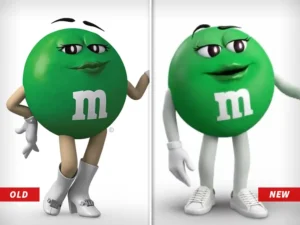
‘Spokescandies’ Melt Away in Heat of Tucker Carlson’s Glare
You know something is wrong when “spokescandies” become targets of culture warriors on the hunt for prey they can turn into clicks. The charming but soon disappearing M&M cartoon characters are the latest victims of polarization for profit.
Fox News’ Tucker Carlson started criticizing the characters last year because of changes to the footwear of two female characters’ – Green M&M went from high heels to flats and Brown M&M switched out stilettos for something more comfortable.
“M&M’s will not be satisfied until every last cartoon character is deeply unappealing and totally androgynous,” Carlson told his listeners. “Until the moment when you wouldn’t want to have a drink with any one of them. That’s the goal. When you’re totally turned off, we’ve achieved equity. They’ve won.” The chyron on his show read, “Candy in sexy shoes is highly offensive”.
Carlson went after the candy ambassadors again following the introduction of a new purple cast member and more shoe adjustments. “The green M&M got her boots back but apparently is now a lesbian, maybe, and there is also a plus-sized, obese purple M&M,” he said.
Tucker Carlson complained Green had gone from gorgeous to someone no one would ask out for a drink
Like most people, I enjoy watching the M&Ms, especially at Christmas when they encounter Santa Claus. As I munch on M&Ms, it never occurs to me to ask one of them on a date.
However, Carlson and other culture warriors apparently live by a different standard that includes objectifying and fantasizing about cartoon characters.
In a statement, Mars Wrigley, which makes M&Ms, one of the oldest U.S. candy brands, said it wasn’t trying to be “woke” as Tucker and other right-wing critics claimed. “In the last year, we’ve made some changes to our beloved spokescandies,” the company said. “We weren’t sure if anyone would even notice.”
“We definitely didn’t think [the changes] would break the internet,” the company added. “But now we get it – even a candy’s shoes can be polarizing.”
In truth, the M&M characters’ shoes are not polarizing unless someone sets out to make them polarizing. Hyper-critics like Carlson look for highly visible targets to polarize because they attract and excite his viewers.
It would be unfair to blame all polarization on the ideological right. The ideological left is capable and willing to engage in polarization for profit, too. Certainly politicians know how to play on polarization to scare up votes.
Because of the furor, the M&Ms are going on indefinite leave and being replaced by Maya Rudolph, the former Saturday Night Live comedian. The company tried to put the best face on the switch of “chief of fun and spokesperson” for the candymaker, suggesting a change had been “in the works for a while”. “We are confident Ms. Rudolph will champion the power of fun to create a world where everyone feels they belong,” the company said. At least until Carlson or another talk-show host finds fault with her.
M&M History
Forrest Mars Sr. got the idea for M&Ms while working in Europe to produce candy bars for U.S. Army rations. He noticed soldiers eating hard-shelled candy that didn’t melt in hot temperatures. When Mars returned home, he replicated the concept and got a patent on the production process. He sourced chocolate from William Murrie, a Hershey executive. The M&M name reflects their collaboration.
The heat-resistant M&Ms gained popularity during World War II. Returning soldiers shared their sweet-tooth appreciation with their families, and sales took off. M&Ms were the first candy taken to space by U.S. astronauts in 1981. Steven Spielberg wanted to feature M&Ms in E.T., but the company declined, so he went instead with Reese’s Pieces.
When sales slowed in the 1990s, the company’s marketers created four anthropomorphic M&M characters (Red, Yellow, Blue and Green) and gave each individual personalities. M&Ms went from aisle candy to icons.

A change in Green M&M’s shoes sparked a charge by Tucker Carlson that the candy maker had gone woke.
More Faux Than Fact
The whole episode engendered by Carlson and carried on by his followers is more faux than fact, a spirit Washington Post columnist Alexandra Petri captured in her spoof titled, “The Final Hours of the M&M’s Spokescandies”.
“’This is all your fault!’ Orange hissed to Green. ‘If you’d just stayed sexy for Tucker Carlson, none of this would be happening! Don’t blame Tucker,’ Red said.”
Green later speculates on whether Red tipped off Tucker, “a human adult male who never interacts with M&Ms except occasionally to eat them if there were no superior candy alternatives available, would have detailed, rant-length thoughts about how she and Brown were no longer sexy enough for his tastes and he didn’t want to have a drink with them anymore?”
Later, Red blames “corporate” for the “awakening” and Green reluctantly agrees. Petri has her think aloud: “Her shoes, formerly go-go boots, which she had read online drove some human beings wild with desire, had suddenly become sensible sneakers. It had been alarming to just find yourself different without knowing it was coming. But Corporate liked to do these things, to amuse itself. Yes, it’s Corporate’s fault.”
“’We can ask our fans for help!’ Yellow suggested, pointing at the ceiling where a fan spun lazily. Corporate had also said Yellow was now no longer a buffoon, that he possessed wisdom of his own and saw the world ‘as it should be.’ Green did not see much of this change in practice.”
“’It’s all artificial,’ Brown said. ‘The changes, the indignation. All of it. We’re not people. We’re not real. We just exist to sell others of our kind.’” And now they are melting away, sexy shoes and all.




